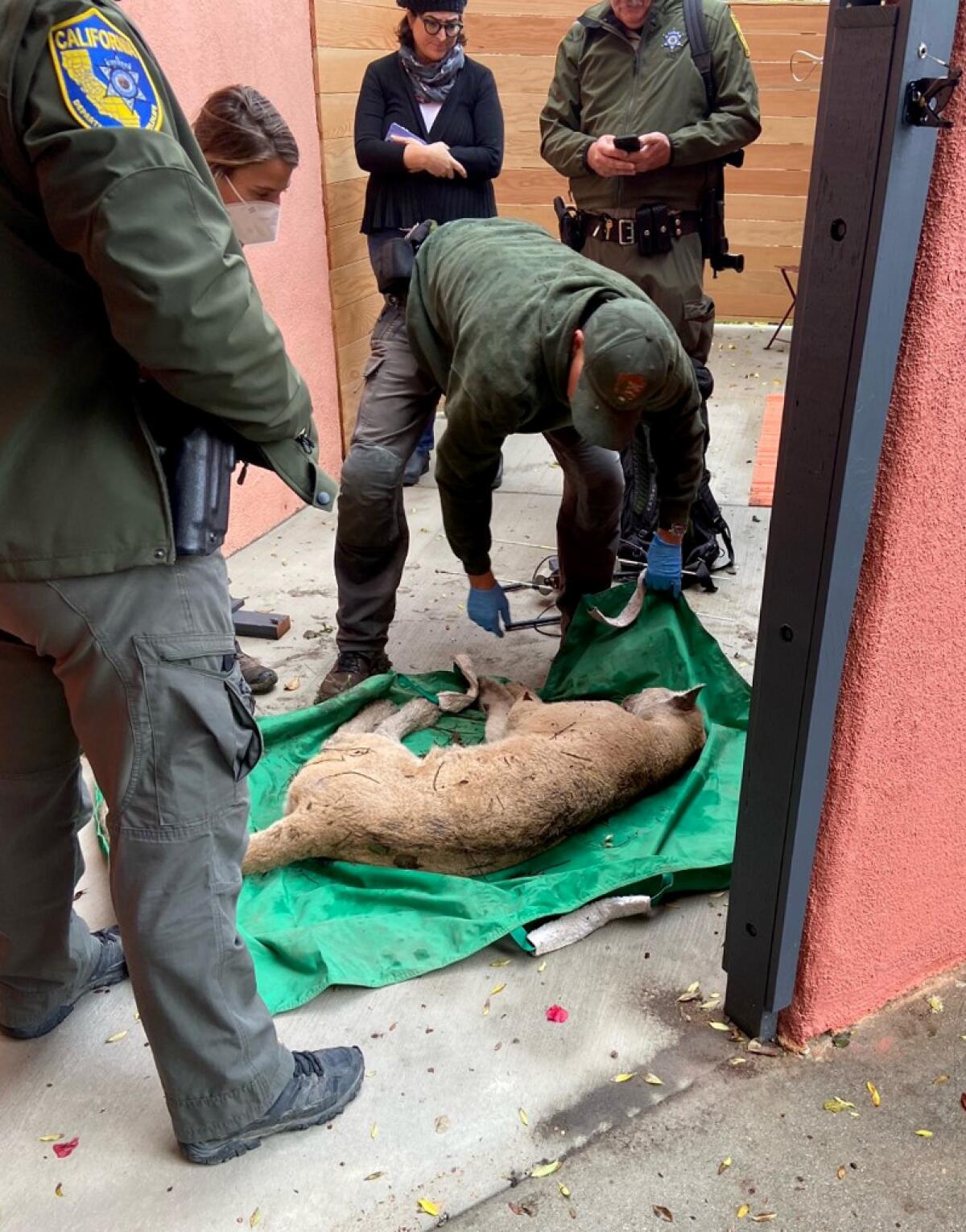P-22, L.A.’s celebrity mountain lion, captured in the backyard of a Los Feliz home

- Share via
More than a decade after crossing the 405 and 101 freeways to reach his longtime home in Griffith Park, the celebrity mountain lion P-22 made a far less glamorous journey Monday, carried out of a Los Feliz backyard in a blanket by scientists who had sedated him for medical testing.
The aging cougar is in stable condition and will undergo further evaluation, the California Department of Fish and Wildlife and National Park Service said Monday evening. Officials said they had received an anonymous report Sunday that P-22 had been hit by a car but did not provide more details on his condition.
They did not say whether they planned to release P-22 in Griffith Park or elsewhere. The agencies said in a joint statement that they had “already been in contact with leading institutions for animal care and rehabilitation centers.”
P-22 is about 12 years old, which is geriatric by wild mountain lion standards. He became a wanted cat last week when wildlife officials announced their plans to trap and evaluate him. Long wary of busy areas, P-22 had started to venture farther south into Silver Lake and stay there longer.
Recent changes in his behavior — including killing a leashed Chihuahua in the Hollywood Hills and attacking another dog in Silver Lake — could be “signs of distress,” officials said.
Beth Pratt, the California regional executive director for the National Wildlife Federation, said she “burst into tears” when she got the news of P-22’s capture Monday.
“It’s so obvious that he’s in some distress, something that has radically changed his behavior,” said Pratt, who for years has called herself “P-22’s agent.”
Nature groups have received a flood of communications from worried Los Angeles residents, wondering whether he is healthy and what will happen next.
“I’d be lying if I said I hadn’t been moved by the communication we’ve received,” Korinna Domingo, founder and director of the Cougar Conservancy, said Monday. The group has seen “just absolute support for him and concern for his well-being.”
The big cat’s capture could mark the end of an era. It’s highly unlikely that another mountain lion could safely cross the 405 and 101 freeways to reach Griffith Park, let alone stay there for so long, feasting on mule deer and occasionally appearing on video doorbell cameras on hilly streets nearby.
For more than a decade, the presence of a mountain lion in the center of Los Angeles has been a source of pride for Angelenos, proof that the city is wilder and more accepting than people may think.
Catching a glimpse of P-22 on a nighttime prowl became one of the most coveted celebrity sightings in Los Angeles. P-22 is so popular that, when wildlife officials announced his wanted status Thursday, they warned civilians to stay away from the big cat and leave the capturing to professionals.
The California Department of Fish and Wildlife’s announcement comes after the mountain lion killed a dog last month and attacked another last week.
On Monday morning, biologists tracked P-22 to a backyard in Los Feliz using the signal from his GPS collar, which sends regular data on his location to scientists conducting a federal study of the local mountain lion population.
Homeowner Sarah Picchi was on a work call when the wildlife officials buzzed her front gate. She heard “something wildlife,” thought the group was canvassing for a charity, and told them it wasn’t a good time.
“The woman said, ‘No, I’m with Wildlife. You have a lion in your backyard,’ ” Picchi said. “Of course, I knew it was P-22, because I’ve been following the story.”
Wildlife officials asked Picchi to keep her dog inside while they sedated P-22 with a dart. Then they carried the big cat out of the muddy yard in a bright green blanket used as a sling. Picchi’s photos and videos show wildlife officials examining the puma on the pavement, loading him into a wildlife crate and lifting it onto the back of a truck. The whole process took about 40 minutes.
Picchi said she was told P-22 had spent the night in the yard and was going to be taken to a zoo for further evaluation.
“It was the most exciting day we’ve ever had at our house,” she said. “My husband and I hope P-22 is safe, and, like the rest of L.A., we’re just rooting for him.”
Angelenos can’t help but see themselves in P-22. He’s carved out a life in a crowded city. And though he’s still handsome for his advanced age, he’s terminally single.
Wildlife officials are continuing to evaluate P-22 in a “top, top facility,” Pratt said Monday. She said scientists are relieved he appears to be in stable condition, but they are still checking him out.
“They’ll have to dive a little deeper, just like you do with people,” Pratt said. That will include a CT scan and evaluations for mange and internal damage from rodenticides, common conditions among Southern California’s urban puma population.
P-22 previously survived a bout of mange after eating an animal that had ingested rat poison. The big cat showed up on trail-camera footage looking gaunt, his tail as thin as a pipe cleaner. Biologists trapped him, treated him with topical medications and vitamin K injections, and released him.
At the time, only two other cougars studied by the federal government had contracted mange, and both eventually died. But P-22 made a full recovery.
What comes after P-22’s health evaluation will depend in part on what biologists find. The agencies said in a joint statement Monday that Fish and Wildlife veterinarians and National Park Service biologists “will determine the best next steps for the animal while also prioritizing the safety of the surrounding communities.”
It is a difficult question with “no magic answers,” especially when dealing with a mountain lion no longer in his prime, Pratt said. She said the CDFW and the NPS will consider all options, including releasing P-22 into the wild or moving him to a wildlife sanctuary.
“Nobody is talking euthanasia,” Pratt said. That could change, she said, if scientists discover that P-22 is suffering from a “really serious health condition,” which could force a conversation about the most humane option, she said.
P-22 surprised the world in 2012 when his fluffy hindquarters appeared on a photograph snapped by a motion-sensing camera in Griffith Park. Miguel Ordeñana, then a 29-year-old wildlife biologist, spotted the “big puma butt” and unmistakable black-tipped tail and couldn’t believe his eyes.
Scientists had assumed P-22 would soon move on in search of a mate and more space to roam. Instead, he stayed in Los Feliz, becoming a bona fide celebrity after National Geographic published a dramatic photo of the mountain lion prowling past the Hollywood sign at night.
The discovery was like “seeing Bigfoot or a chupacabra,” said Ordeñana, who now works for the Natural History Museum. Within weeks, the National Park Service had trapped the puma and given him a tracking collar and a name: P-22. (That’s P for puma, the 22nd in the federal study of local pumas.) P-22 is now the oldest puma in the study.
More to Read
Sign up for Essential California
The most important California stories and recommendations in your inbox every morning.
You may occasionally receive promotional content from the Los Angeles Times.


















